Land Use and Land Cover Change Effects on the Value of Ecosystem Services in the Konqi River Basin, China, under Ecological Water Conveyance Conditions
Abstract
1. Introduction
2. Materials and Methods
2.1. Study Area
2.2. Data Resources and Pre-Processing
2.3. Analysis of Land Use Change Characteristics
2.4. ESV Assessment Model Construction
2.5. Sensitivity and Elasticity of ESV
2.6. Characterization of Changes in the Value of ES
3. Results
3.1. Analysis of Land Use Change in the Konqi Typical River Basin
3.1.1. Land Use Structure Evolution Characteristics
3.1.2. Land Use Transfer Characteristics
3.2. Analysis of Spatial and Temporal Variations in ESV
3.2.1. Dynamic Changes in ESV
3.2.2. Analysis of Spatial Changes in ESV
3.2.3. Sensitivity Analysis of ES
3.3. Spatial Autocorrelation Analysis
4. Discussion
4.1. Analysis of Land Use Dynamic
4.2. Analysis of ESV
5. Conclusions
Author Contributions
Funding
Institutional Review Board Statement
Informed Consent Statement
Data Availability Statement
Acknowledgments
Conflicts of Interest
References
- Ge, Q.; Xu, W.; Fu, M.; Han, Y.; An, G.; Xu, Y. Ecosystem service values of gardens in the Yellow River Basin, China. J. Arid Land 2022, 14, 284–296. [Google Scholar] [CrossRef]
- Xie, G.D.; Xiao, Y.; Lu, C.X. Study on Ecosystem Services: Progress, Limitation and Basic Paradigm. J. Plant Ecol. 2006, 20, 191–199. [Google Scholar]
- Zulpiya, M.; Umut, H.; Tayierjiang, A.; Ayinuer, A. Correction: Ecological effect of the riparian ecosystem in the lower reaches of the Tarim River in northwest China. PLoS ONE 2019, 14, e0214007. [Google Scholar] [CrossRef]
- Hu, S.; Yang, Y.; Li, A.; Liu, K.; Mi, C.; Shi, R. Integrating Ecosystem Services Into Assessments of Sustainable Development Goals: A Case Study of the Beijing-Tianjin-Hebei Region, China. Front. Environ. Sci. 2022, 10, 897792. [Google Scholar] [CrossRef]
- Yang, R.; Ren, F.; Xu, W.; Ma, X.; Zhang, H.; He, W. China’s ecosystem service value in 1992-2018: Pattern and anthropogenic driving factors detection using Bayesian spatiotemporal hierarchy model. J Env. Manag. 2022, 302, 114089. [Google Scholar] [CrossRef] [PubMed]
- Fu, B.J.; Zhang, L.W. Land-use change and ecosystem services: Concepts, methods and progress. Prog. Geogr. 2014, 33, 441–446. [Google Scholar]
- Shifaw, E.; Sha, J.; Li, X.; Bao, Z.; Zhou, Z. An insight into land-cover changes and their impacts on ecosystem services before and after the implementation of a comprehensive experimental zone plan in Pingtan island, China. Land Use Policy 2019, 82, 631–642. [Google Scholar] [CrossRef]
- Li, S.; Wang, J.; Zhu, W.; Zhang, J.; Liu, Y.; Gao, Y.; Wang, Y.; Li, Y. Research framework of ecosystem services geography from spatial and regional perspectives. Acta Geogr. Sin. 2014, 69, 1628–1639. [Google Scholar]
- Costanza, R.; d’Arge, R.; de Groot, R.; Farber, S.; Grasso, M.; Hannon, B.; Limburg, K.; Naeem, S.; O’Neill, R.V.; Paruelo, J.; et al. The value of the world’s ecosystem services and natural capital. Ecol. Econ. 1998, 25, 3–15. [Google Scholar] [CrossRef]
- Kellert, S.R. Assessing Wildlife and Environmental Values in Cost-Benefit Analysis. J. Environ. Manag. 1984, 18, 4. [Google Scholar]
- Limburg, K.E.; O’Neill, R.V.; Costanza, R.; Farber, S. Complex systems and valuation. Ecol. Econ. 2002, 41, 409–420. [Google Scholar] [CrossRef]
- Tolessa, T.; Senbeta, F.; Abebe, T. Land use/land cover analysis and ecosystem services valuation in the central highlands of Ethiopia. For. Trees Livelihoods 2017, 26, 111–123. [Google Scholar] [CrossRef]
- Groot, R.d.; Brander, L.; Ploeg, S.v.d.; Costanza, R.; Bernard, F.; Braat, L.; Christie, M.; Crossman, N.; Ghermandi, A.; Hein, L.; et al. Global estimates of the value of ecosystems and their services in monetary units. Ecosyst. Serv. 2012, 1, 50–61. [Google Scholar] [CrossRef]
- Costanza, R.; de Groot, R.; Sutton, P.; van der Ploeg, S.; Anderson, S.J.; Kubiszewski, I.; Farber, S.; Turner, R.K. Changes in the global value of ecosystem services. Glob. Environ. Chang. 2014, 26, 152–158. [Google Scholar] [CrossRef]
- Xie, G.D.; Zhang, C.X.; Zhang, L.M.; Chen, W.H.; Li, S.M. Improvement of the Evaluation Method for Ecosystem Service Value Based on Per Unit Area. J. Nat. Resour. 2015, 30, 1243–1254. [Google Scholar]
- Biratu, A.A.; Bedadi, B.; Gebrehiwot, S.G.; Melesse, A.M.; Nebi, T.H.; Abera, W.; Tamene, L.; Egeru, A. Ecosystem Service Valuation along Landscape Transformation in Central Ethiopia. Land 2022, 11, 500. [Google Scholar] [CrossRef]
- Fontaine, C.M.; Dendoncker, N.; De Vreese, R.; Jacquemin, I.; Marek, A.; Van Herzele, A.; Devillet, G.; Mortelmans, D.; François, L. Towards participatory integrated valuation and modelling of ecosystem services under land-use change. J. Land Use Sci. 2014, 9, 278–303. [Google Scholar] [CrossRef]
- Carpenter, S.R.; Mooney, H.A.; Agard, J.; Capistrano, D.; DeFries, R.S.; Diaz, S.; Dietz, T.; Duraiappah, A.K.; Oteng-Yeboah, A.; Pereira, H.M.; et al. Science for managing ecosystem services: Beyond the Millennium Ecosystem Assessment. Proc. Natl. Acad. Sci. USA 2009, 106, 1305–1312. [Google Scholar] [CrossRef]
- Bojie, F.; Dandan, Y. Trade-off analyses and synthetic integrated method of multiple ecosystem services. Resour. Sci. 2016, 38, 1–9. [Google Scholar] [CrossRef]
- Jiang, W.; Wu, T.; Fu, B. The value of ecosystem services in China: A systematic review for twenty years. Ecosyst. Serv. 2021, 52, 101365. [Google Scholar] [CrossRef]
- Chen, Y.; Li, Z.; Li, P.; Zhang, Y.; Liu, H.; Pan, J. Impacts and Projections of Land Use and Demographic Changes on Ecosystem Services: A Case Study in the Guanzhong Region, China. Sustainability 2022, 14, 3003. [Google Scholar] [CrossRef]
- Yan, Y.; Yao, L.Y.; Lang, L.M.; Zhao, M.J. Revaluation of ecosystem services in inland river basins of China:Based on meta-regression analysis. Acta Geogr. Sin. 2019, 74, 1040–1057. [Google Scholar]
- Huang, L.; He, C.; Wang, B. Study on the spatial changes concerning ecosystem services value in Lhasa River Basin, China. Environ. Sci. Pollut. Res. 2022, 29, 7827–7843. [Google Scholar] [CrossRef]
- Hu, S.; Ma, R.; Sun, Z.; Ge, M.; Zeng, L.; Huang, F.; Bu, J.; Wang, Z. Determination of the optimal ecological water conveyance volume for vegetation restoration in an arid inland river basin, northwestern China. Sci. Total Environ. 2021, 788, 147775. [Google Scholar] [CrossRef]
- Huang, F.; Chunyu, X.; Zhang, D.; Chen, X.; Ochoa, C.G. A framework to assess the impact of ecological water conveyance on groundwater-dependent terrestrial ecosystems in arid inland river basins. Sci. Total Environ. 2020, 709, 136155. [Google Scholar] [CrossRef]
- Shi, H.; Wang, F.; Bai, Y.; Sun, H.; Ai, J.; Hu, Q.; Zhao, Y.; Yang, E. Evaluation of the Ecosystem Service’s Function in the Lower Reaches of the Shiyang River, Gansu. J. Glaciol. Geocryol. 2009, 31, 1195–1200. [Google Scholar]
- Mamat, Z.; Halik, Ü.; Keyimu, M.; Keram, A.; Nurmamat, K. Variation of the floodplain forest ecosystem service value in the lower reaches of Tarim River, China. Land Degrad. Dev. 2018, 29, 47–57. [Google Scholar] [CrossRef]
- Li, Q.; Xue, Z.; Chen, H.; Xu, C. Cognitive ecology and payment decision-making behavior based on the theory of CVM in the Tarim River Basin. Resour. Sci. 2016, 38, 1075–1087. [Google Scholar]
- Su, X.L.; Kang, S.Z.; Tong, L. A dynamic evaluation method and its application for the ecosystem service value of an inland river basin: A case study on the Shiyanghe River Basin in Hexi Corridor of Gansu Province. Acta Ecol. Sin. 2006, 26, 2011–2019. [Google Scholar]
- Wang, Y.; Ding, J.; Li, X.; Zhang, J.; Ma, G. Impact of LUCC on ecosystem services values in the Yili River Basin based on an intensity analysis model. Acta Ecol. Sin. 2022, 42, 3106–3118. [Google Scholar]
- Zhang, Z.; Xu, Z.; Cheng, G.; Su, Z. Contingent Valuation of the Economic Benefits of Restoring Ecosystem Services of Zhangye Prefecture of Heihe River Basin. Acta Ecol. Sin. 2002, 22, 885–893. [Google Scholar]
- Li, W.; Wumairjiang, W.; Ma, Y.; He, Y.; Wang, J.; Zhu, C. Ecological Water Conveyance Project Based on River-Lake-Reservoir Connected System in the Kongque River. Desert Oasis Meteorol. 2019, 13, 130–135. [Google Scholar] [CrossRef]
- Lu, L.; Chen, Y.; Li, X. Effect of ecological water conveyance on groundwater depth and vegetation in the Kongque River. Arid Zone Res. 2021, 38, 901–909. [Google Scholar] [CrossRef]
- Fu, A.; Li, W.; Chen, Y.; Liu, Y. Suitable oasis scales under a government plan in the Kaidu-Konqi River Basin of northwest arid region, China. PeerJ 2018, 6, e4943. [Google Scholar] [CrossRef]
- Yang, Q.; Xu, C.; Zhang, J.; Luo, Y.; Chen, L. Phenological characteristics of vegetation and its response to climatic change in the Kaidu-Kongqi River basin, Xinjiang, during 2001–2017. Arid Zone Res. 2020, 37, 729–738. [Google Scholar] [CrossRef]
- Zhang, J.; Meng, F.; Bao, A.; Li, C.; Qi, X.; Liu, T.; Zhang, P. LUCC Analysis of the Upstream of the Kongqi River, Xinjiang, China. J. Desert Res. 2018, 38, 664–672. [Google Scholar]
- Liu, H.; Sun, L.; Lv, W.; Shu, C.; Zhang, H. Evaluation and Change Analysis of Ecosystem Service Value in Erhai Lake Basin Based on Land Use Change. Ecol. Econ. 2022, 38, 147–152. [Google Scholar]
- Su, Y.; Zhang, E.; Liu, Y.; Liu, G.; Lin, F. Land-use change and ecological environment effects on Fenhe River Basin. Arid Zone Res. 2022, 39, 968–977. [Google Scholar] [CrossRef]
- Xie, G.D.; Zhen, L.; Lu, C.X.; Xiao, Y.; Chen, C. Expert Knowledge Based Valuation Method of Ecosystem Services in China. J. Nat. Resour. 2008, 23, 911–919. [Google Scholar]
- Zhang, X.; He, S.; Yang, Y. Evaluation of wetland ecosystem services value of the yellow river delta. Environ. Monit. Assess. 2021, 193, 353. [Google Scholar] [CrossRef]
- Fa, Z.; Rusuli, Y.; Tuersun, A. Spatio-temporal change of ecosystem service value in Bosten Lake Watershed based on land use. Acta Ecol. Sin. 2021, 41, 5254–5265. [Google Scholar]
- Zhang, S.; Wang, Y.; Xia, T.; Chang, X.; Li, Z. Effects of land use/cover change on ecosystem service value under the ecological water conveyance of Tarim River. Arid Land Geogr. 2021, 44, 739–749. [Google Scholar]
- Tolessa, T.; Senbeta, F.; Kidane, M. The impact of land use/land cover change on ecosystem services in the central highlands of Ethiopia. Ecosyst. Serv. 2017, 23, 47–54. [Google Scholar] [CrossRef]
- Junguo, L.; Chuanfu, Z.; Shiying, T.; Jianguo, L.; Hong, Y.; Shaofeng, J.; Liangzhi, Y.; Bo, L.; Miao, Z. Water conservancy projects in China: Achievements, challenges and way forward Glob. Environ. Chang. 2013, 23, 633–643. [Google Scholar] [CrossRef]
- Zhang, J.; Li, J.; Bao, A.; Bai, J.; Liu, T.; Huang, Y. Effectiveness assessment of ecological restoration of Populus euphratica forest in the Tarim River Basin during 2013–2020. Arid Land Geogr. 2022, 45, 1824–1835. [Google Scholar]
- Zhou, H.; Chen, Y.; Yang, Y.; Zhu, C. Effects of ecological water conveyance on the growth characteristics of Populus euphtatica in the lower reaches of Tarim River based on tree-rings. Arid Land Geogr. 2021, 44, 643–650. [Google Scholar]
- Guo, H. Analysis of the Impact of the Ecological Water Delivery Project on the Change of Groundwater Level in the Lower Reaches of the Tarim River. Northwest Hydropower 2020, 185, 29–32. [Google Scholar]
- Li, N.; Wang, J.; Wang, H.; Fu, B.; Chen, J.; He, W. Impacts of land use change on ecosystem service value in Lijiang River Basin, China. Environ. Sci. Pollut. Res. 2021, 28, 46100–46115. [Google Scholar] [CrossRef]
- Abulizi, A.; Yang, Y.; Mamat, Z.; Luo, J.; Abdulslam, D.; Xu, Z.; Zayiti, A.; Ahat, A.; Halik, W. Land-Use Change and its Effects in Charchan Oasis, Xinjiang, China. Land Degrad. Dev. 2016, 28, 106–115. [Google Scholar] [CrossRef]
- Zhu, W.; Gao, Q.; Duan, M.; Guo, Y.; Li, Y.; Wan, Y.; Bian, D.; Wei, L. Ecological Capital Assessment for the Alpine Grassland Ecosystem in the Northwest Alpine Pastoral Area of Tibet. J. Nat. Resour. 2011, 26, 419–428. [Google Scholar]
- Ma, X.; Zhang, H. Land-Use/Land-Cover Change and Ecosystem Service Provision in Qinghai Province, China: From the Perspective of Five Ecological Function Zones. Land 2023, 12, 656. [Google Scholar] [CrossRef]
- Zhao, J.; Liu, S.; Wang, Z.; Gao, H.; Feng, S.; Wei, B.; Hou, Z.; Xiao, F.; Jing, L.; Liao, X. The Impact of Land Use and Landscape Pattern on Ecosystem Services in the Dongting Lake Region, China. Remote Sens. 2023, 15, 2228. [Google Scholar] [CrossRef]
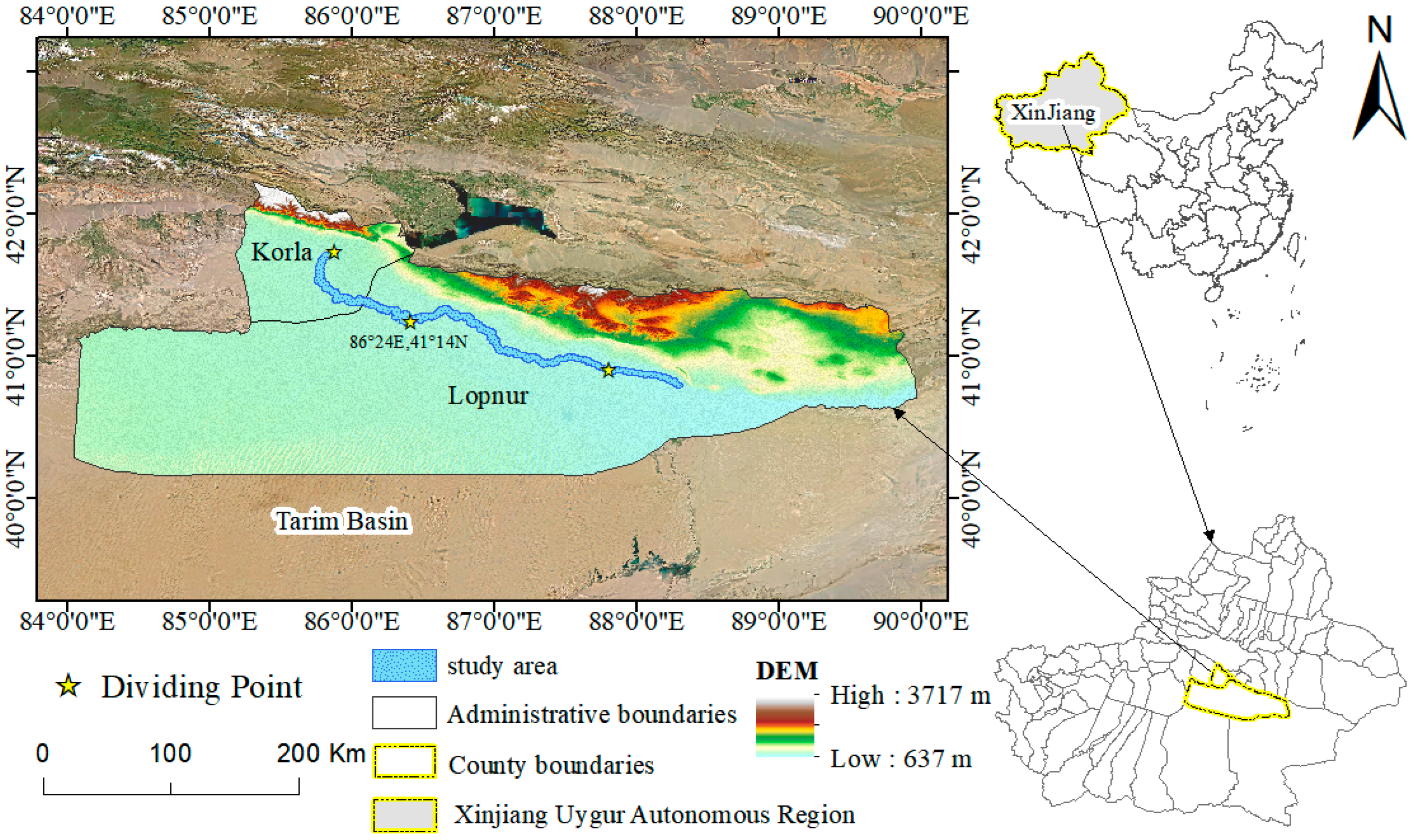
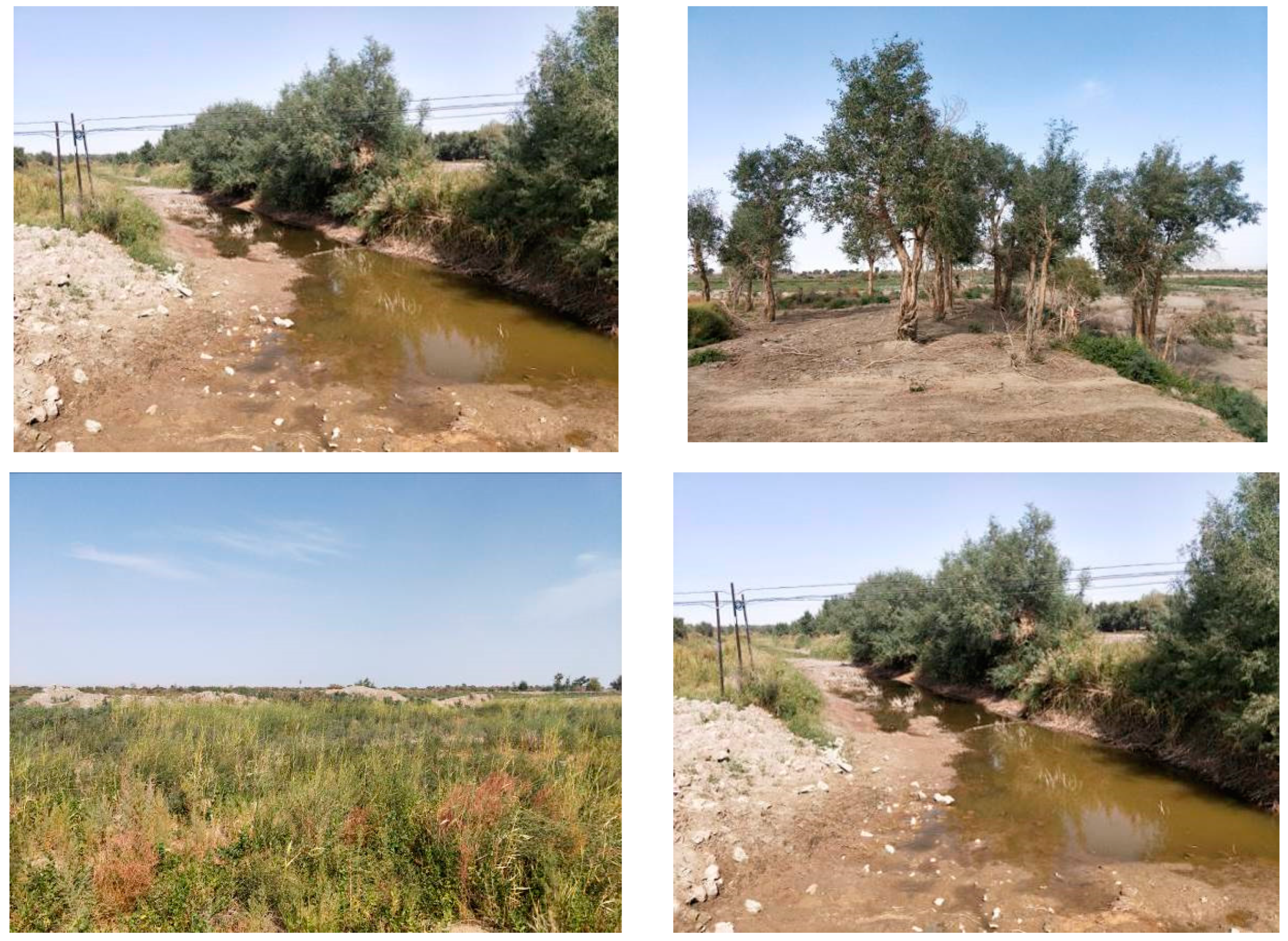
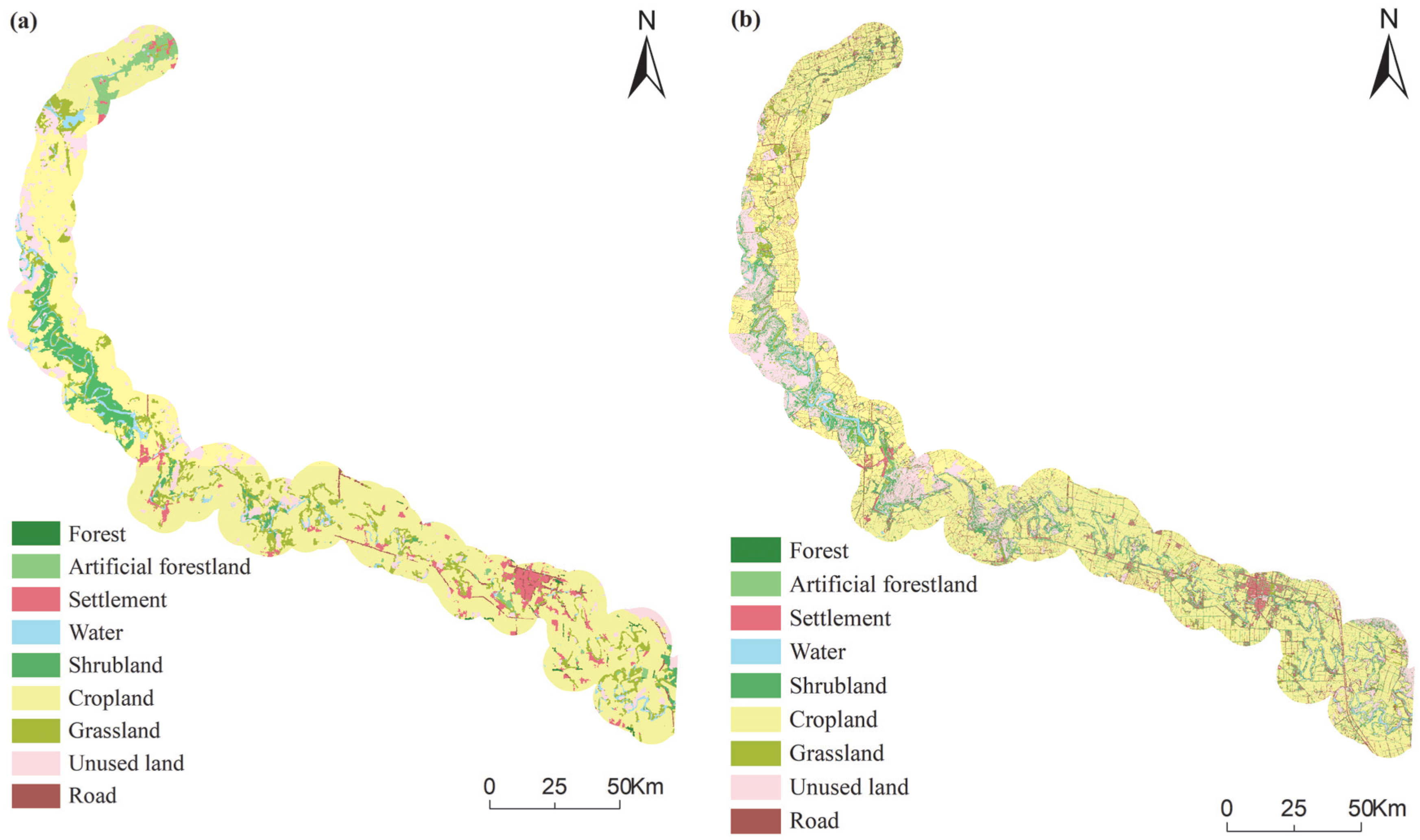

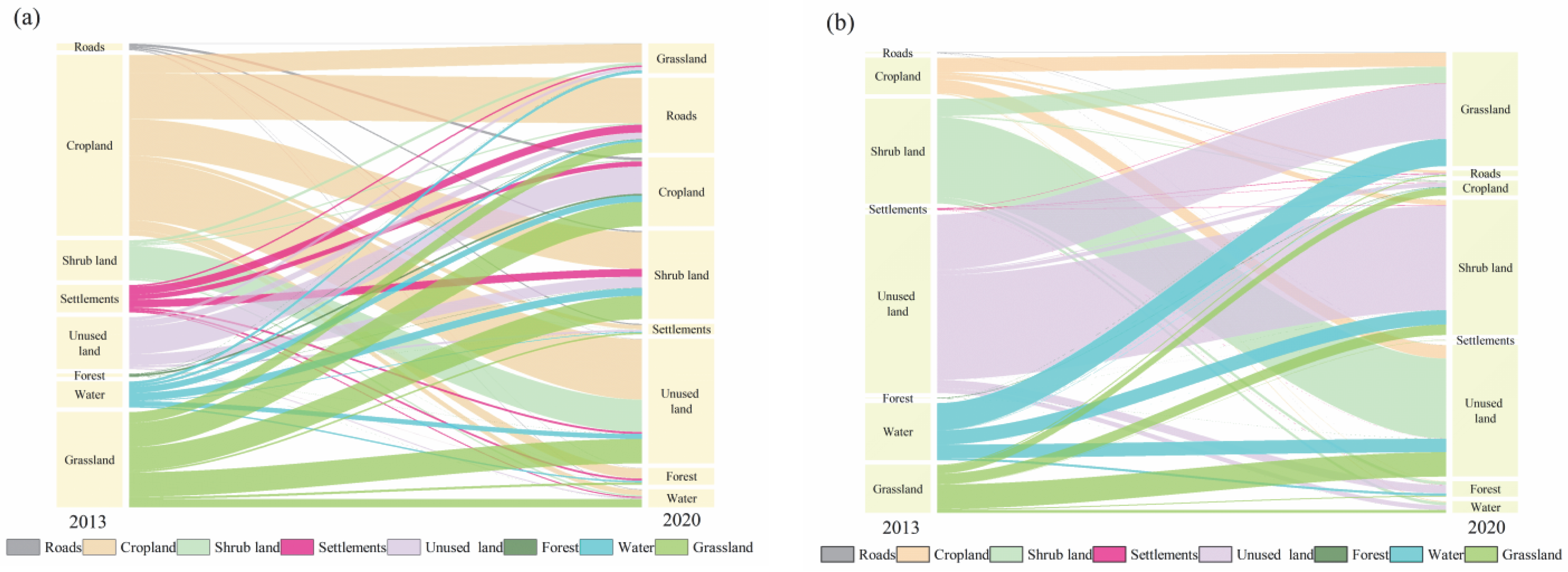
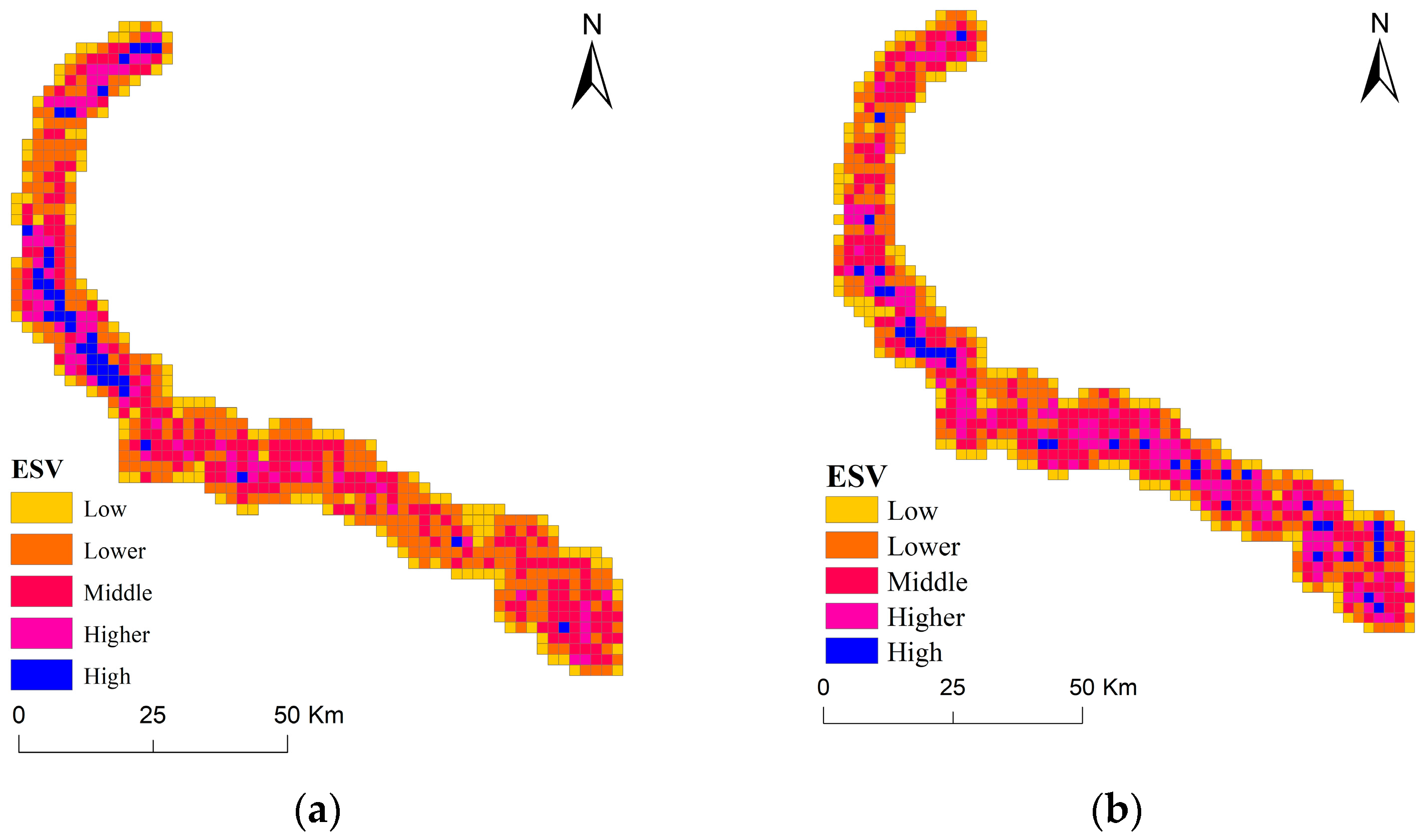

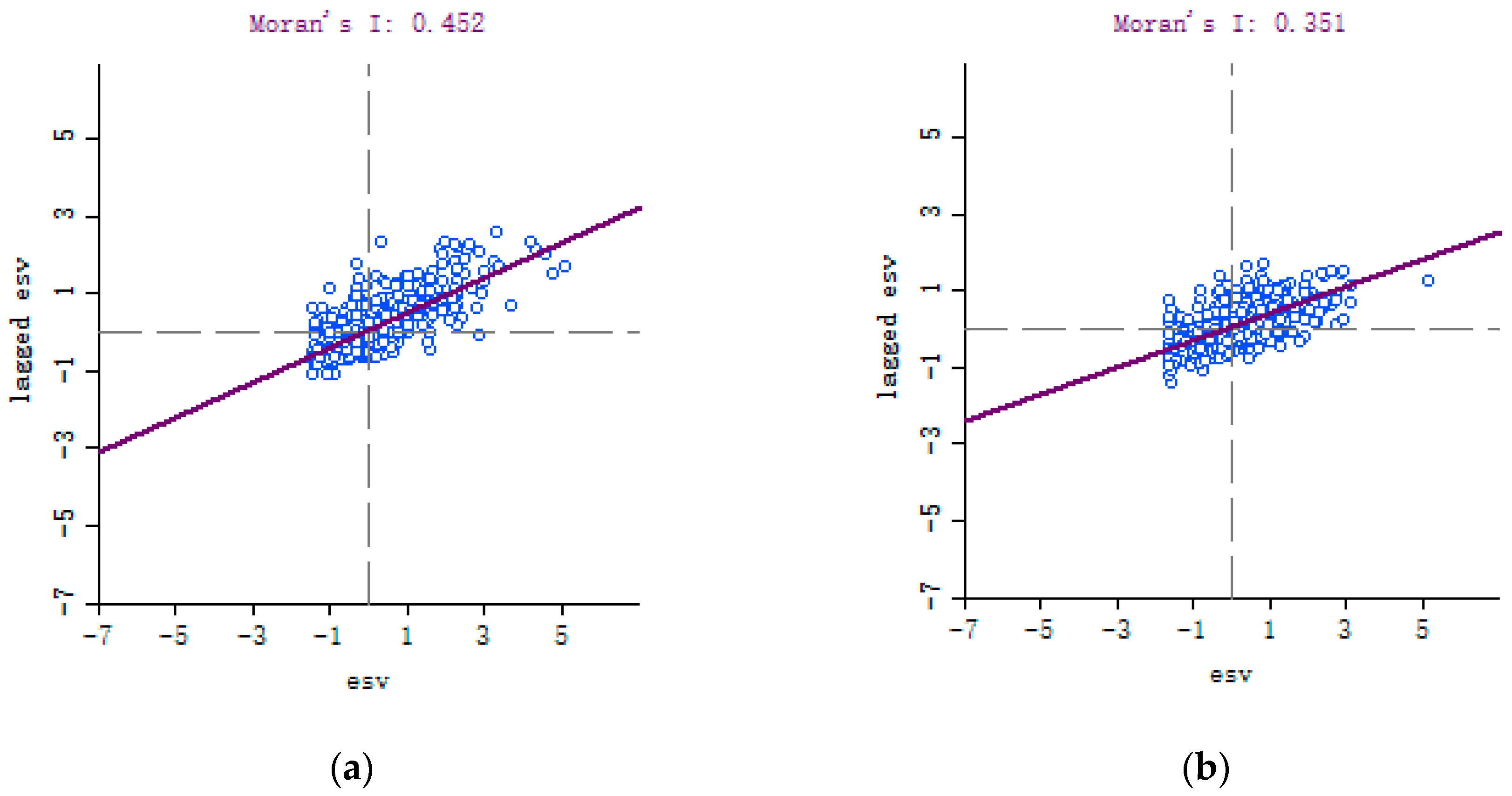
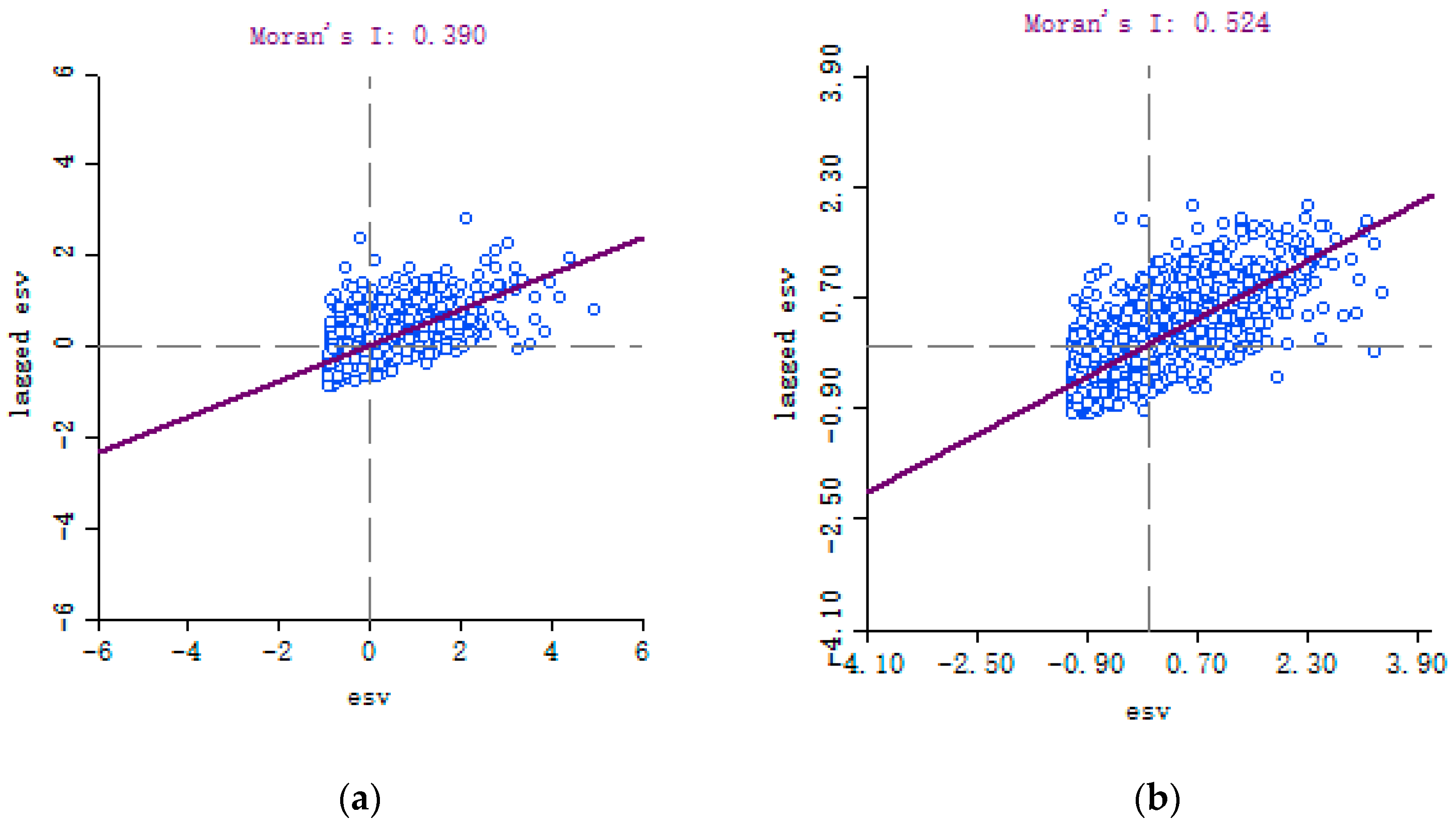
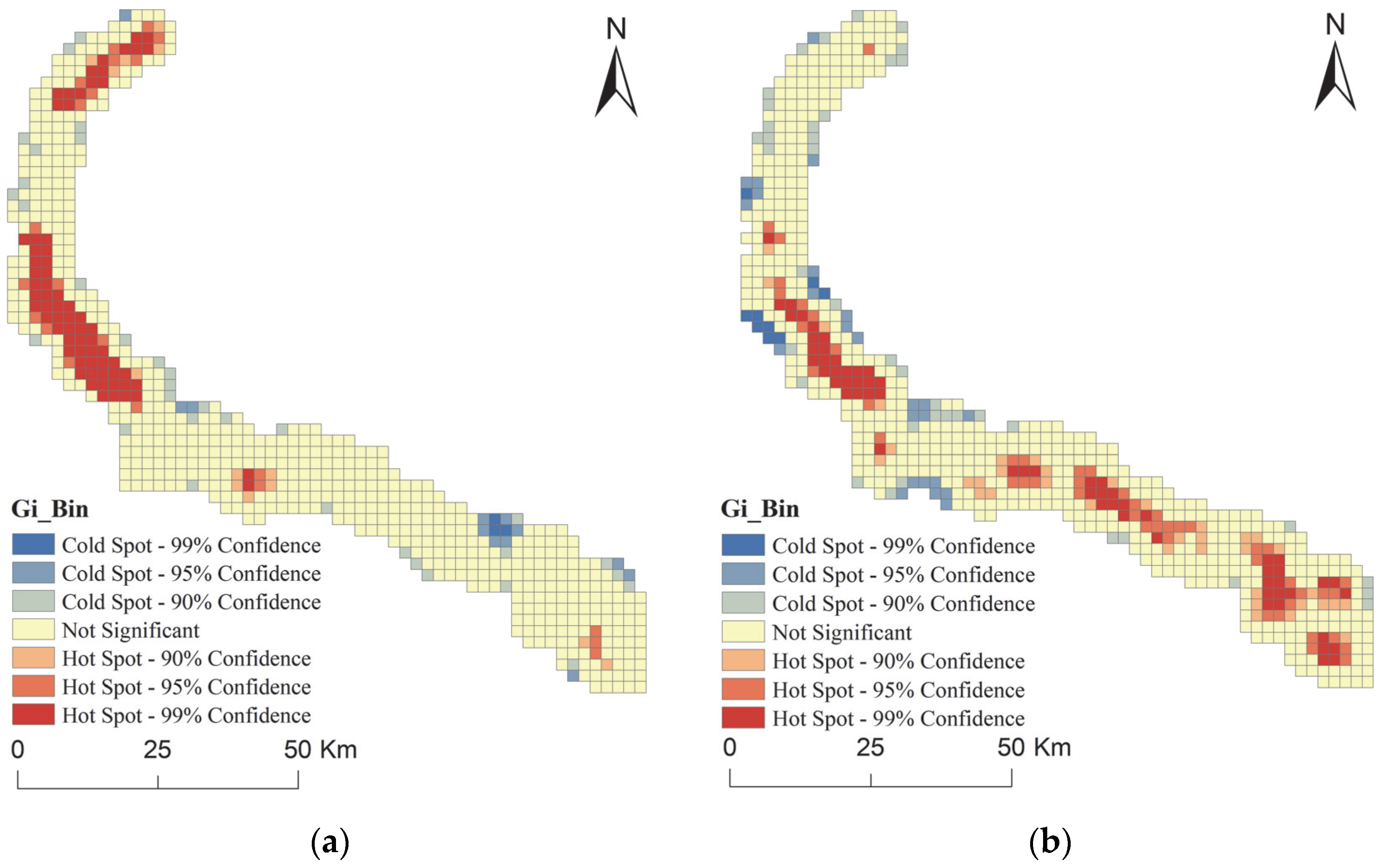

| Land Use Type | Ecosystem Type | Ecosystem Service Value Coefficient | ||||||||
|---|---|---|---|---|---|---|---|---|---|---|
| FP | RM | GR | CR | HR | WT | SC | BM | ALP | ||
| Cropland | Farmland | 526.12 | 205.19 | 378.81 | 510.34 | 405.11 | 731.31 | 773.40 | 536.64 | 89.44 |
| Forest | Forest | 173.62 | 1567.84 | 2272.84 | 2141.31 | 2151.83 | 904.93 | 2115.00 | 2372.80 | 1094.33 |
| Grassland | Grassland | 226.23 | 189.40 | 789.18 | 820.75 | 799.70 | 694.48 | 1178.51 | 983.84 | 457.72 |
| Water | Water body | 278.84 | 184.14 | 268.32 | 1083.81 | 9875.26 | 7812.88 | 215.71 | 1804.59 | 2335.97 |
| Unused land | Desert | 10.52 | 21.04 | 31.57 | 68.40 | 36.83 | 136.79 | 89.44 | 210.45 | 126.27 |
| Settlement | Town | 0 | 0 | 0 | 0 | 0 | 0 | 0 | 0 | 0 |
| River Basin | Upper Reaches | |||
|---|---|---|---|---|
| Area Percentage (2013) | Area Percentage (2020) | Rate of Change | Single Land Use Dynamic Degree | |
| Grassland | 8.49% | 2.84% | −66.61% | −0.1 |
| Roads | 0.87% | 6.08% | 594.94% | 0.85 |
| Cropland | 68.33% | 57.61% | −15.69% | −0.02 |
| Shrub land | 5.08% | 8.86% | 74.54% | 0.11 |
| Settlement | 3.52% | 1.78% | −49.30% | −0.07 |
| Unused land | 8.01% | 13.51% | 68.81% | 0.1 |
| Forest | 0.31% | 1.44% | 371.38% | 0.53 |
| Artificial forestland | 2.31% | 5.52% | 138.81% | 0.2 |
| Water | 3.09% | 2.35% | −23.83% | −0.03 |
| River Basin | Lower Reaches | |||
|---|---|---|---|---|
| Area Percentage (2013) | Area Percentage (2020) | Rate of Change | Single Land Use Dynamic Degree | |
| Grassland | 3.77% | 7.73% | 105.15% | 0.15 |
| Roads | 0.08% | 0.35% | 323.72% | 0.46 |
| Cropland | 8.63% | 6.89% | −20.10% | −0.03 |
| Shrub land | 9.48% | 11.37% | 19.92% | 0.03 |
| Settlement | 0.15% | 0.06% | −59.27% | −0.08 |
| Unused land | 73.42% | 70.46% | −4.04% | −0.01 |
| Forest | 0.05% | 1.55% | 2841.20% | 4.06 |
| Artificial forestland | —— | —— | —— | —— |
| Water | 4.42% | 1.58% | −64.29% | −0.09 |
| Basin | Year | Ecosystem Service Value | ||||
|---|---|---|---|---|---|---|
| FP | RM | GR | CR | HR | ||
| Upper reaches | 2013 | 2218.74 | 1570.97 | 2826.75 | 3437.85 | 4522.96 |
| 2020 | 1906.26 | 2093.44 | 3375.37 | 3817.63 | 4608.81 | |
| Variation value | 312.48 | −522.47 | −548.62 | −379.78 | −85.85 | |
| Lower reaches | 2013 | 716.17 | 1737.26 | 2726.55 | 3189.02 | 5910.55 |
| 2020 | 672.00 | 1902.03 | 3109.84 | 3364.27 | 4195.77 | |
| Variation value | 44.17 | −164.77 | −383.29 | −175.25 | 1714.78 | |
| Typical Konqi River Basin | 2013 | 2934.91 | 3308.23 | 5553.29 | 6626.87 | 10,433.51 |
| 2020 | 2578.25 | 3995.47 | 6485.21 | 7181.90 | 8804.57 | |
| Variation value | 356.65 | −687.24 | −931.91 | −555.03 | 1628.93 | |
| Basin | Year | Ecosystem Service Value | ||||
| WT | SC | BM | ALP | Total | ||
| Upper reaches | 2013 | 4866.96 | 4448.81 | 3898.10 | 1472.67 | 29,263.80 |
| 2020 | 4346.78 | 4590.88 | 4329.20 | 1711.53 | 30,779.89 | |
| Variation value | 520.18 | −142.07 | −431.10 | −238.86 | −1516.09 | |
| Lower reaches | 2013 | 4872.48 | 3267.58 | 4494.61 | 2640.76 | 29,554.97 |
| 2020 | 3364.54 | 3696.70 | 4553.77 | 2357.56 | 27,216.48 | |
| Variation value | 1507.94 | −429.12 | −59.16 | 283.20 | 2338.50 | |
| Typical Konqi River Basin | 2013 | 9739.45 | 7716.38 | 8392.71 | 4113.43 | 58,818.77 |
| 2020 | 7711.33 | 8287.58 | 8882.97 | 4069.09 | 57,996.36 | |
| Variation value | 2028.12 | −571.19 | −490.26 | 44.34 | 822.41 | |
| Basin | Year | Ecosystem Service Value | ||||||
|---|---|---|---|---|---|---|---|---|
| Cropland | Forest | Grassland | Water | Unused Land | Settlement | Total | ||
| Upper reaches | 2013 | 15,693.08 | 6290.23 | 2881.25 | 4075.72 | 323.53 | 0 | 29,263.80 |
| 2020 | 13,231.42 | 12,936.10 | 961.96 | 3104.27 | 546.14 | 0 | 30,779.89 | |
| Variation value | 2461.67 | −6645.87 | 1919.29 | 971.44 | −222.61 | 0 | −1516.09 | |
| Lower reaches | 2013 | 2738.17 | 12,904.02 | 1767.11 | 8046.01 | 4099.67 | 0 | 29,554.97 |
| 2020 | 2187.87 | 14,596.00 | 3625.21 | 2873.37 | 3934.02 | 0 | 27,216.48 | |
| Variation value | 550.29 | −1691.98 | −1858.11 | 5172.64 | 165.65 | 0 | 2338.50 | |
| Typical Konqi River Basin | 2013 | 18,431.25 | 19,194.25 | 4648.35 | 12,121.72 | 4423.20 | 0 | 58,818.77 |
| 2020 | 15,419.29 | 27,532.10 | 4587.18 | 5977.64 | 4480.16 | 0 | 57,996.36 | |
| Variation value | 3011.96 | −8337.85 | 61.18 | 6144.08 | −56.96 | 0 | 822.41 | |
| Basin | Year | Sensitivity Index of Ecosystem Service Value | |||||
|---|---|---|---|---|---|---|---|
| Cropland | Forest | Grassland | Water | Unused Land | Settlement | ||
| Upper reaches | 2013 | 0.536 | 0.215 | 0.098 | 0.139 | 0.011 | 0.000 |
| 2020 | 0.430 | 0.420 | 0.031 | 0.101 | 0.018 | 0.000 | |
| Lower reaches | 2013 | 0.093 | 0.437 | 0.060 | 0.272 | 0.139 | 0.000 |
| 2020 | 0.080 | 0.536 | 0.133 | 0.106 | 0.145 | 0.000 | |
| Typical Konqi River Basin | 2013 | 0.313 | 0.326 | 0.079 | 0.206 | 0.075 | 0.000 |
| 2020 | 0.266 | 0.044 | 0.079 | 0.103 | 0.077 | 0.000 | |
Disclaimer/Publisher’s Note: The statements, opinions and data contained in all publications are solely those of the individual author(s) and contributor(s) and not of MDPI and/or the editor(s). MDPI and/or the editor(s) disclaim responsibility for any injury to people or property resulting from any ideas, methods, instructions or products referred to in the content. |
© 2023 by the authors. Licensee MDPI, Basel, Switzerland. This article is an open access article distributed under the terms and conditions of the Creative Commons Attribution (CC BY) license (https://creativecommons.org/licenses/by/4.0/).
Share and Cite
Akbar, A.; Abulizi, A.; Abliz, A.; Abliz, A.; Jiang, J.; Yu, T.; Ou, B. Land Use and Land Cover Change Effects on the Value of Ecosystem Services in the Konqi River Basin, China, under Ecological Water Conveyance Conditions. Forests 2023, 14, 1028. https://doi.org/10.3390/f14051028
Akbar A, Abulizi A, Abliz A, Abliz A, Jiang J, Yu T, Ou B. Land Use and Land Cover Change Effects on the Value of Ecosystem Services in the Konqi River Basin, China, under Ecological Water Conveyance Conditions. Forests. 2023; 14(5):1028. https://doi.org/10.3390/f14051028
Chicago/Turabian StyleAkbar, Adila, Abudukeyimu Abulizi, Abdugheni Abliz, Abdulla Abliz, Jiao Jiang, Tingting Yu, and Bin Ou. 2023. "Land Use and Land Cover Change Effects on the Value of Ecosystem Services in the Konqi River Basin, China, under Ecological Water Conveyance Conditions" Forests 14, no. 5: 1028. https://doi.org/10.3390/f14051028
APA StyleAkbar, A., Abulizi, A., Abliz, A., Abliz, A., Jiang, J., Yu, T., & Ou, B. (2023). Land Use and Land Cover Change Effects on the Value of Ecosystem Services in the Konqi River Basin, China, under Ecological Water Conveyance Conditions. Forests, 14(5), 1028. https://doi.org/10.3390/f14051028






